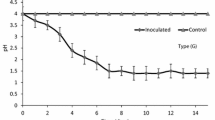Abstract
The efficiency of surfactant application to improve or inhibit metal solubilization and sulfur oxidation kinetics during the bioleaching of heavy metal-contaminated sediments was studied in suspension-leaching experiments. The river sediment used contained large amounts of fine particles and organic matter. Three types of surfactants were tested: sodium dodecylsulfate (SDS), a C12/14-alkanolethoxylate (Präwozell F1214/5N), and a wettable sulfur (Netz- schwefel 80 WP). Adding 10 mmol SDS/l led to transient inhibition of acidification, metal solubilization and sulfur oxidation. Inhibiting bioleaching for just 14 days required about ten times more SDS than the amount used for mine waste mitigation. The use of Präwozell resulted in poor inhibition; and using of wettable sulfur did not improve leaching efficiency. The bulk of these surfactants was sorbed onto the solid particles immediately on application, while the remainder in the aqueous phase disappeared within a few days.
Similar content being viewed by others
Author information
Authors and Affiliations
Additional information
Received: 24 March 2000 / Received revision: 6 July 2000 / Accepted: 9 July 2000
Rights and permissions
About this article
Cite this article
Seidel, H., Ondruschka, J., Morgenstern, P. et al. Bioleaching of heavy metal-contaminated sediments by indigenous Thiobacillus spp: metal solubilization and sulfur oxidation in the presence of surfactants. Appl Microbiol Biotechnol 54, 854–857 (2000). https://doi.org/10.1007/s002530000465
Issue Date:
DOI: https://doi.org/10.1007/s002530000465




